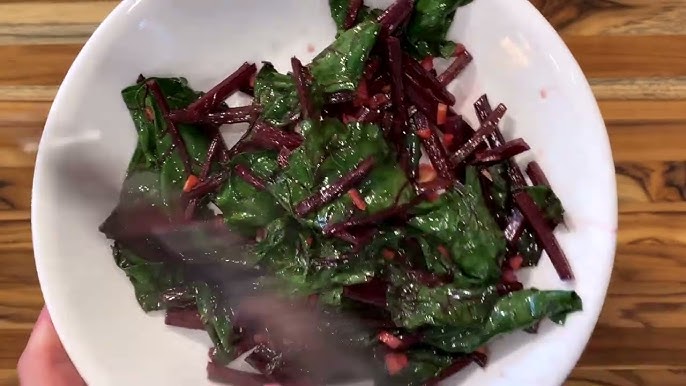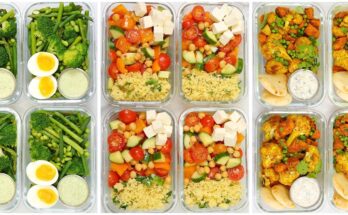Beet Greens Recipe: Beet greens are the leafy tops of the beetroot plant. While many people discard them, these vibrant green leaves are not only edible but incredibly nutritious and flavorful. Think of them as a hidden gem in your produce drawer—tender, slightly bitter, and packed with goodness. They resemble Swiss chard in texture and can be cooked similarly to spinach, collards, or kale. If you’ve been tossing these tops into the trash, it’s time to rethink that habit and explore their full potential in your kitchen.
Nutritional Benefits of Beet Greens
These greens are nothing short of a nutritional powerhouse. They are rich in vitamins A, C, and K, all of which play crucial roles in maintaining healthy vision, boosting immunity, and supporting bone health. They also offer a solid dose of minerals like magnesium, potassium, and iron—essential for everything from muscle function to energy production.
One of the standout benefits of beet greens is their high fiber content, which promotes digestive health and helps manage blood sugar levels. Plus, they’re loaded with antioxidants that combat inflammation and oxidative stress. Whether you’re trying to eat healthier, add variety to your meals, or reduce waste, beet greens are a fantastic choice.
Why You Should Cook with Beet Greens
Sustainability and Reducing Food Waste
Cooking with beet greens is a simple yet powerful way to practice sustainability in your kitchen. Every year, tons of food is wasted simply because consumers don’t realize the potential of edible plant parts like beet tops. By using these greens, you’re not only saving money but also reducing your environmental footprint.
Using the whole vegetable honors the work of farmers and the natural resources used in growing them. It’s a respectful, eco-friendly, and resourceful habit that also opens the door to culinary creativity. Imagine turning what many consider waste into a delicious and nutritious dish—now that’s smart cooking.
Flavor Profile and Culinary Versatility
Beet greens offer a slightly earthy, mildly bitter taste that pairs beautifully with a range of flavors—from garlic and olive oil to lemon and chili flakes. Their texture is soft but hearty, making them ideal for sautéing, adding to soups, tossing in pastas, or incorporating into grain bowls.
These greens can be a standalone side dish or a complementary component of a more complex recipe. Their versatility means you can use them in breakfast scrambles, lunchtime wraps, or dinner-time stir-fries. And if you’re feeling adventurous, blend them into a smoothie or pesto for a nutrient-dense twist.
How to Select and Store Beet Greens
Choosing the Freshest Greens
When shopping for beet greens, look for vibrant, deep green leaves with no yellowing or wilting. The stems should be firm and not slimy. Ideally, you want to pick bunches where the greens are still attached to fresh, firm beets—that’s a solid indicator of overall freshness.
If you’re buying from a farmer’s market, ask the vendor when the beets were harvested. Fresher greens are not only tastier but also more nutrient-dense. The quicker you use them after purchase, the better their flavor and texture will be in your dishes.
Proper Storage Tips for Longer Freshness
To keep beet greens fresh, start by separating them from the beetroot if you’re not using them immediately. Store them in a sealed plastic bag or reusable produce bag with a paper towel to absorb excess moisture. Place the bag in the vegetable drawer of your refrigerator.
Use the greens within 2 to 3 days for the best flavor and texture. If you notice slight wilting, you can still revive them by soaking the leaves in a bowl of cold water for 10–15 minutes before cooking. This trick works like a charm and makes the greens perk up beautifully.
Ingredients for a Simple Beet Greens Recipe
Basic Ingredients You’ll Need
To make a quick and tasty beet greens dish, gather the following:
- 1 bunch of fresh beet greens
- 2 tablespoons olive oil
- 3 garlic cloves, minced
- ½ teaspoon red pepper flakes (optional)
- Salt and black pepper to taste
- Juice of half a lemon
This simple combination highlights the natural flavor of the greens while adding enough zest and spice to make it a stand-alone dish or side.
Optional Add-ons and Flavor Enhancers
Want to jazz things up a bit? Consider adding these extras:
- Chopped onions or shallots for a sweeter, savory base
- A splash of balsamic vinegar for depth
- Grated Parmesan or crumbled feta for a creamy touch
- Toasted pine nuts or walnuts for crunch
- A fried or poached egg on top for a complete meal
These add-ons allow you to tweak the recipe to fit your taste preferences or dietary needs. The beauty of beet greens is how adaptable they are to different cuisines and styles.
Step-by-Step Guide to Cooking Beet Greens
Step 1: Wash and Prepare the Greens
Begin by trimming the beet greens from the root and separating any large stems from the leaves. Rinse them thoroughly in cold water to remove dirt and grit—these leaves grow close to the ground, so don’t skip this step.
After washing, pat them dry with a kitchen towel or use a salad spinner. Chop the leaves and stems into bite-sized pieces. Don’t toss the stems! They offer a nice crunch and add texture to your dish.
Step 2: Sautéing the Aromatics
Heat the olive oil in a large skillet over medium heat. Once hot, add minced garlic (and onions if using) and sauté until fragrant, about 1-2 minutes. Be careful not to burn the garlic; a gentle golden-brown color is what you’re aiming for.
This aromatic base lays the foundation for your beet greens, infusing them with a depth of flavor that complements their natural taste.
Step 3: Cooking the Greens
Add the chopped beet greens to the skillet in batches, allowing each handful to wilt down before adding the next. Stir continuously to ensure even cooking.
After about 5-7 minutes, the greens should be tender but still vibrant. Sprinkle in the red pepper flakes, salt, and pepper, adjusting to your preference. If they seem dry, you can add a splash of water or broth.
Step 4: Seasoning and Serving Suggestions
Right before serving, squeeze some fresh lemon juice over the greens. This adds brightness and helps balance the slight bitterness of the leaves. Serve immediately as a side dish, or use it as a topping for grains, proteins, or toast.
Creative Ways to Use Leftover Beet Greens
Incorporating Beet Greens into Other Meals
Once you’ve mastered the basic sautéed beet greens recipe, the possibilities for incorporating them into other dishes are practically endless. One great option is to mix them into a morning omelet or frittata. The greens add a vibrant color and a burst of nutrition that elevates your breakfast to a new level.
Another smart move? Stir them into pasta or grain bowls. Whether it’s quinoa, brown rice, or couscous, beet greens add texture and flavor that turns a plain bowl into something hearty and satisfying. Top it off with a protein of your choice—grilled chicken, tofu, or a poached egg—and you’ve got a complete, balanced meal.
Soup lovers, don’t miss out: beet greens can easily be tossed into brothy soups or hearty stews in the last few minutes of cooking. Their quick-cooking nature means they soften quickly, adding a pleasant earthiness without overpowering the dish.
Beet Greens Smoothies and Juices
Yes, you read that right—beet greens can go into your morning smoothie. When blended with fruits like banana, apple, or berries, their bitterness is masked, and you’re left with a nutrient-dense drink that kicks off your day on the right note. Add a touch of lemon juice or ginger for a zesty twist.
If you juice at home, throw in beet greens along with your usual veggies and fruits. Not only do they juice well, but they also contribute significantly to the drink’s vitamin and mineral profile.
Tips for Making Beet Greens Taste Better
Balancing the Bitterness
Bitterness is one of the biggest hurdles for people new to beet greens. Luckily, a few kitchen tricks can help tone it down. Adding acidic components like lemon juice or vinegar not only enhances the flavor but also cuts through the bitterness, making the greens more palatable.
Another method is to cook them with naturally sweet ingredients like caramelized onions or roasted garlic. These flavors provide a counterbalance and help mellow out the sharpness.
A final trick? Blanching. Quickly boiling the beet greens for about 30 seconds before sautéing can reduce bitterness and help retain their vibrant color.
Pairing with Complementary Ingredients
Beet greens work best when paired with ingredients that enhance their unique taste. Here are a few winning combos:
- Creamy elements like goat cheese or Greek yogurt
- Crunchy textures from nuts, seeds, or crispy chickpeas
- Sweet accents such as dried cranberries or a drizzle of honey
- Savory spices like cumin, smoked paprika, or curry powder
These pairings can be mixed and matched based on your personal preference, creating dishes that are anything but boring.
Common Mistakes to Avoid When Cooking Beet Greens
Overcooking the Greens
Beet greens cook quickly, and overdoing it can turn them mushy and flavorless. Aim for a cook time of 5-7 minutes max. They should be tender but still have a bit of bite. Overcooking also dulls their vibrant green color, making the dish less visually appealing.
Skipping the Cleaning Process
Since beet greens grow close to the soil, they tend to carry a lot of dirt and grit. Skipping a thorough rinse can result in a sandy, unpleasant texture. Always wash them multiple times in cold water and spin dry for best results.
Underseasoning
Because beet greens have a strong natural flavor, they need a bit of help to shine. Don’t be shy with your seasonings—garlic, olive oil, salt, pepper, and acids like lemon juice are key to unlocking their potential.
FAQs about Beet Greens Recipe
1. Are beet greens safe to eat?
Yes, absolutely! Beet greens are not only safe to eat, but they’re also incredibly nutritious. Packed with vitamins A, C, and K, they make a delicious and healthy addition to your meals.
2. What do beet greens taste like?
Beet greens have a slightly earthy, mildly bitter taste—somewhere between Swiss chard and spinach. When sautéed or steamed, their flavor mellows beautifully.
3. Can you eat beet greens raw?
Yes, you can eat beet greens raw in salads or smoothies. Just wash them thoroughly and slice them thin for the best texture and taste.
4. How do I store beet greens?
Store unwashed beet greens in a plastic bag in the fridge. They stay fresh for up to 3 days. For longer storage, blanch and freeze them.
5. Do beet greens shrink when cooked?
Oh yes, like most leafy greens, they shrink a lot! A whole bunch might cook down to just a cup, so be generous when prepping.
6. Can I substitute beet greens for other greens in recipes?
Totally! Beet greens work well as a substitute for spinach, kale, or Swiss chard in most recipes—soups, stir-fries, and omelets included.
7. Are beet greens good for juicing?
You bet! They add a nutritious kick to green juices and pair well with fruits like apples and citrus for a more balanced flavor.
8. Can kids eat beet greens?
Yes, kids can eat them. Just make sure they’re cooked well and seasoned lightly—maybe with garlic or butter—to soften the flavor.
Conclusion
Beet greens are a surprisingly delicious and incredibly nutritious part of the beet plant that often gets overlooked. With the right preparation and flavor pairing, they can transform into a savory side dish, a vibrant smoothie booster, or a nutrient-packed addition to your main meals. By embracing this often-discarded vegetable, you’re not just cooking smarter—you’re eating better and doing your part to reduce waste.
From sautéing to smoothies, from grain bowls to soups, beet greens are as versatile as they are healthy. Next time you buy a bunch of beets, don’t toss those greens—turn them into something wonderful.



